Chapter 1: Introduction to accounting
Chapter learning objectives
Upon completion of this chapter you will be able to:
- define accounting
- explain the different types of business entity:
- sole trader
- partnership
- limited liability company
- explain who users of the financial statements are and their information needs
- explain the nature, principles and scope of accounting
- explain how the accounting system contributes to providing useful information and complies with organisational policies and deadlines.
1 Definition of accounting
Analysing data is also an important feature of accounting. Financialstatements are prepared so that we can examine and evaluate allinformation, in order to make key decisions.
2 Types of business entity
A business can be organised in one of several ways:
- Sole trader – a business owned and operated by one person.
- Partnership – a business owned and operated by two or more people.
- Company – a business owned by many people and operated by many (though not necessarily the same) people.

 Differences between a sole trader, partnership and company
Differences between a sole trader, partnership and company
Sole trader
The simplest form of business is the sole trader. This is ownedand managed by one person, although there might be any number ofemployees. A sole trader is fully and personally liable for any lossesthat the business might make.
Partnership
A partnership is a business owned jointly by a number ofpartners. The partners are jointly and severally liable for any lossesthat the business might make. Traditionally the big accounting firmshave been partnerships, although some are converting their status tolimited liability companies.
Companies
Companies are owned by shareholders. There can be one shareholderor many thousands of shareholders. Shareholders are also known asmembers. Each shareholder owns part of the company. As a group, theyelect the directors who run the business. Directors often own shares intheir companies, but not all shareholders are directors.
Companies are almost always limited companies. This means that theshareholders will not be personally liable for any losses the companyincurs. Their liability is limited to the nominal value of the sharesthat they own. Their shares may become worthless, but they will not beforced to make good the losses.
This limited liability is achieved by treating the company as a completely separate legal entity.
For all three types of entity, the money put up by the individual,the partners or the shareholders, is referred to as the businesscapital. In the case of a company, this capital is divided into shares.
Advantages and disadvantages of operating as a limited company, sole trader or partnership
Sole trader
As the name suggests, this is an organisation owned by one person.
Accounting conventions recognise the business as a separate entityfrom its owner. However, legally, the business and personal affairs of asole trader are not distinguished in any way. The most importantconsequences of this is that a sole trader has complete personal unlimited liability. Business debts which cannot be paid from business assets must be met from sale of personal assets, such as a house or a car.
Sole trading organisations are normally small because they have to rely on the financial resources of their owner.
The advantages of operating as a sole trader include flexibilityand autonomy. A sole trader can manage the business as he or she likesand can introduce or withdraw capital at any time.
Partnership
A partnership is two or more persons associated for the purposeof a business or a profession. Like a sole trader, a partnership is notlegally distinguished from its members. Personal assets of the partnersmay have to be used to pay the debts of the partnership business.
The advantages of trading as a partnership stem mainly from there being many owners rather than one. This means that:
- more resources may be available, including capital, specialist knowledge, skills and ideas;
- administrative expenses may be lower for a partnership than for the equivalent number of sole traders, due to economies of scale; and
- partners can substitute for each other.
Partners can introduce or withdraw capital at any time, provided that all the partners agree.
Limited company
A limited company is a distinct, artificial 'person' created inorder to separate legal responsibility for the affairs of a business (orany other activity) from the personal affairs of the individuals whoown and/or operate the business.
The owners are known as shareholders (or members) and the peoplewho run the business are known as directors. In a small corporation,owners and directors are often the same people.
Limited Liability
The concept of limited liability is based on the premise that thecompany's debts and liabilities are those of the company and not thoseof the members.
Limited liability refers to the liability of each shareholder beinglimited to any unpaid amount on their shares. Usually, all the sharesare fully paid so the members have no liability.
Comparison of limited companies to sole traders and partnerships
The fact that a company is a separate legal entity means that itis very different from a sole trader or partnership in a number of ways.
- Number of members
There is no upper limit on the number of members in a company. In a partnership, except in certain restricted categories, such as accountants and stockbrokers, the maximum number of partners is 20. This limitation on numbers makes it difficult for a partnership to raise large amounts of capital.
- Security for loans
A company has greater scope for raising loans by, for example, borrowing on debentures (long-term borrowings) and may secure them with floating charges. A floating charge is a mortgage over the constantly fluctuating assets of a company providing security for the lender of money to a company. It does not prevent the company dealing with the assets in the ordinary course of business. Such a charge is useful when a company has no non-current assets such as land, but does have a large and valuable inventories.
The law does not permit partnerships or individuals to secure loans with a floating charge.
Formalities, publicity and expenses
When they are being formed, companies have to register and tofile a Memorandum and Articles of Association (formal constitutiondocuments) with the Registrar. Registration fees and legal costs have tobe paid.
The accounts of larger limited companies are subject to an annualaudit inspection (this requirement has been lifted for small companies).The costs associated with this can be high. Partnerships and soletraders are not subject to this requirement unless as members ofprofessional bodies whose own rules apply.
A registered company's accounts and certain other documents areopen to public inspection. The accounts of sole traders and partnershipsare not open to public inspection.
Capital maintenance
Limited companies are subject to strict rules in connection with the introduction and withdrawal of capital and profits.
Management powers
Members of a company may not take part in its management unlessthey are directors, whereas all partners are entitled to share inmanagement, unless the partnership agreement provides otherwise.

3 Users of the financial statements
Different user groups are interested in a company's financial statements for different reasons:
- Management need detailed information in order to control their business and plan for the future. Budgets will be based upon past performance and future plans. These budgets will then be compared with actual results. Information will also be needed about the profitability of individual departments and products. Management information must be very up to date and is normally produced on a monthly basis.
- Investors and potential investors are interested in their potential profits and the security of their investment. Future profits may be estimated from the target company’s past performance as shown in the income statement. The security of their investment will be revealed by the financial strength and solvency of the company as shown in the statement of financial position. The largest and most sophisticated groups of investors are the institutional investors, such as pension funds and unit trusts.
- Employees and trade union representatives need to know if an employer can offer secure employment and possible pay rises. They will also have a keen interest in the salaries and benefits enjoyed by senior management. Information about divisional profitability will also be useful if a part of the business is threatened with closure.
- Lenders need to know if they will be repaid. This will depend on the solvency of the company, which should be revealed by the statement of financial position. Long-term loans may also be backed by ‘security’ given by the business over specific assets. The value of these assets will be indicated in the statement of financial position.
- Government agencies need to know how the economy is performing in order to plan financial and industrial policies. The tax authorities also use financial statements as a basis for assessing the amount of tax payable by a business.
- Suppliers need to know if they will be paid. New suppliers may also require reassurance about the financial health of a business before agreeing to supply goods.
- Customers need to know that a company can continue to supply them into the future. This is especially true if the customer is dependent on a company for specialised supplies.
- Competitors wish to compare their own performance against that of other companies and learn as much as possible about their rivals in order to help develop strategic plans.
- The public may wish to assess the effect of the company on the economy, local environment and local community. Companies may contribute to their local economy and community through providing employment and patronising local suppliers. Some companies also run corporate responsibility programmes through which they support the environment, economy and community by, for example supporting recycling schemes.

 Test your understanding 1
Test your understanding 1
Which of the following users do you think require the most detailed financial information to be made available to them?
A Competitors
B Management of the business
C Trade unions
D Investors

4 Types of accounting

 Financial accounting and management accounting
Financial accounting and management accounting
Financial accounting
Financial accounting is concerned with the production offinancial statements for external users. These are a report on thedirectors’ stewardship of the funds entrusted to them by theshareholders.
Investors need to be able to choose which companies to invest inand compare their investments. In order to facilitate comparison,financial accounts are prepared using accepted accounting conventionsand standards. International Accounting Standards (IASs) andInternational Financial Reporting Standards (IFRSs) help to reduce thedifferences in the way that companies draw up their financial statementsin different countries.
The financial statements are public documents, and therefore theywill not reveal details about, for example, individual products’profitability.
Management accounting
Management require much more detailed and up-to-date informationin order to control the business and plan for the future. They need tobe able to cost-out products and production methods, assessprofitability and so on. In order to facilitate this, managementaccounts present information in any way which may be useful tomanagement, for example by operating unit or product line.
Management accounting is an integral part of management activityconcerned with identifying, presenting and interpreting information usedfor:
- formulating strategy
- planning and controlling activities
- decision making
- optimising the use of resources.

5 How an accounting system contributes to providing useful information
The main features of an accounting system and how it helps in providing information to the business are as follows:
- In a computerised system all information about the business transactions can be quickly accessed. This will help in decision making.
- It provides details of transactions of the business in the relevant accounts.
- When the accounts are closed off the balances for each outstanding account are determined. This will give the value of assets and liabilities in the business.
- It gives a summary of outstanding balances.
- This summary can then be used for the preparation of financial statements.
- Normally the financial statements are prepared at regular intervals. The accounting system will allow the business to obtain the data and also prepare the financial statements to determine the profitability, liquidity, risks, etc. applicable to the business for a particular period. For internal reporting purposes this could be monthly, whilst for external reporting purposes this is usually yearly.
6 The regulatory system
Structure of the international regulatory system
International Financial Reporting Standards (IFRS) Foundation
The IFRS Foundation (formerly known as the International Accounting Standards Committee Foundation (IASC)):
- is the supervisory body for the IASB
- has 22 trustees
- is responsible for governance issues and ensuring each body is properly funded
The objectives of the IFRS Foundation are to:
- develop a set of global accounting standards which are of high quality, are understandable and are enforceable
- which require high quality, transparent and comparable information in financial statements to help those in the world’s capital markets and other users make economic decisions
- promote using and applying these standards
- bring about the convergence of national and international accounting standards.
International Accounting Standards Board (IASB)
The IASB:
- is solely responsible for issuing International Accounting Standards (IASs)
- standards now called International Financial Reporting Standards (IFRSs)
- is made up of 15 members
- has the same objectives as the IFRS Foundation.
The IASB and national standard setters
The intentions of the IASB are:
- to develop a single set of understandable and enforceable high quality worldwide accounting standards, however
- the IASB cannot enforce compliance with its standards, therefore
- it needs the co-operation of national standard setters.
In order to achieve this the IASB works in partnership with the major national standard-setting bodies:
- All the most important national standard setters are represented on the IASB and their views are taken into account so that a consensus can be reached.
- All national standard setters can issue IASB discussion papers and exposure drafts for comment in their own countries, so that the views of all preparers and users of financial statements can be represented.
- Each major national standard setter ‘leads’ certain international standard-setting projects.
The IASB intends to develop a single set of understandable and enforceable high quality worldwide accounting standards.
As far as possible, future international standards will be morerigorous than previously and will no longer allow alternativetreatments. The Chairman of the IASB, Sir David Tweedie has alreadystated that there will not be ‘convergence for the sake of convergenceby the issue of a set of ‘lowest common denominator’ accountingstandards’.
Because the IASB on its own cannot enforce compliance with itsstandards, it needs the co-operation of national standard setters.Without their support, rigorous new international standards are unlikelyto be adopted by everybody. Therefore, the IASB works in partnershipwith the major national standard setting bodies, including the UKAccounting Standards Board (ASB) and the US Financial AccountingStandards Board (FASB).
Each major national standard setter ‘leads’ certaininternational standard-setting projects, e.g. the UK ASB is carrying outmuch of the work to develop a new international standard on leasing.
All the major national standard-setters are now committed to international convergence.
The regulatory framework of accounting in each country which usesIFRS is affected by a number of legislative and quasi-legislativeinfluences as well as IFRS:
- national company law
- EU directives
- security exchange rules.
Why a regulatory framework is necessary
A regulatory framework for the preparation of financial statements is necessary for the following reasons:
- Financial statements are used by a wide range of users – investors, lenders, customers, etc.
- They need to be useful to these users.
- They need to be comparable.
- They need to provide at the least some basic information.
- They increase users’ understanding of, and confidence in, financial statements.
- They regulate the behaviour of companies towards their investors.
Accounting standards on their own would not be a completeregulatory framework. In order to fully regulate the preparation offinancial statements and the obligations of companies and directors,legal and market regulations are also required.
Principles-based and rules-based framework
Principles-based framework:
- based upon a conceptual framework such as the IASB's Framework
- accounting standards are set on the basis of the conceptual framework.
Rules-based framework:
- ‘Cookbook’ approach
- accounting standards are a set of rules which companies must follow.
In the UK there is a principles-based framework in terms of theStatement of Principles and accounting standards and a rules-basedframework in terms of the Companies Acts, EU directives and stockexchange rulings.

 IFRIC
IFRIC
International Financial Reporting Interpretations Committee (IFRIC)
- issues rapid guidance on accounting matters where divergent interpretations of IFRSs have arisen
- issues interpretations called IFRIC 1, IFRIC 2, etc.
The IFRIC addresses issues of reasonably widespread importance,not issues that are of concern to only a small minority of entities. Theinterpretations cover both:
- newly identified financial reporting issues not specifically dealt with in IFRSs; or
- issues where unsatisfactory or conflicting interpretations have developed, or seem likely to develop in the absence of authoritative guidance, with a view to reaching a consensus on the appropriate treatment.
In 1997 the IASC formed the Standing Interpretations Committee(SIC) to ensure proper compliance with IFRSs by considering points ofcontention where divergent interpretations have emerged and issuing anauthoritative view; 33 interpretations (entitled SIC 1, SIC 2, etc) wereissued by the SIC before its change of name (see below).
SICs are important because IAS 1 (revised) states that financialstatements cannot be described as complying with IFRSs unless theycomply with each IAS/IFRS and each interpretation from the SIC/IFRIC.
In 2002 the SIC changed its name to the International FinancialReporting Interpretations Committee (IFRIC). Interpretations are nowdesignated IFRIC 1, IFRIC 2, etc.


 IFRS Advisory Council (IAC)
IFRS Advisory Council (IAC)
The Advisory Council (formerly known as the Standards AdvisoryCouncil – SAC) provides a forum for the IASB to consult a wide rangeof interested parties affected by the IASB's work, with the objectiveof:
- advising the Board on agenda decisions and priorities in the Board's work,
- informing the Board of the views of the organisations and individuals on the Council on major standard-setting projects, and
- giving other advice to the Board or to the Trustees.


 Development of an IFRS
Development of an IFRS
The procedure for the development of an IFRS is as follows:
- The IASB identifies a subject and appoints an advisory committee to advise on the issues.
- The IASB publishes an exposure draft for public comment, being a draft version of the intended standard.
- Following the consideration of comments received on the draft, the IASB publishes the final text of the IFRS.
- At any stage the IASB may issue a discussion paper to encourage comment.
- The publication of an IFRS, exposure draft or IFRIC interpretation requires the votes of at least eight of the 15 IASB members.
Status of IFRS's
Neither the IFRS Foundation, the IASB nor the accountancyprofession has the power to enforce compliance with IFRSs. Nevertheless,some countries adopt IFRSs as their local standards, and others ensurethat there is minimum difference between their standards and IFRSs. Inrecent years, the status of the IASB and its standards has increased, soIFRSs carry considerable persuasive force worldwide.

7 Company ownership and control
 | - A ‘joint stock company’ is a company which has issued shares.
- Since the formation of joint stock companies in the 19th century, they have become the dominant form of business organisation within the UK.
- Companies that are quoted on a stock market such as the London Stock Exchange are often extremely complex and require a substantial investment in equity to fund them, i.e. they often have large numbers of shareholders.
- Shareholders delegate control to professional managers (the board of directors) to run the company on their behalf. The board act as agents (see later).
- Shareholders normally play a passive role in the day-to-day management of the company.
- Directors own less than 1% of the shares of most of the UK’s 100 largest quoted companies and only four out of ten directors of listed companies own any shares in their business.
- Separation of ownership and control leads to a potential conflict of interests between directors and shareholders.
|
8 What is ‘corporate governance’?
The Cadbury Report 1992 provides a useful definition:
- 'the system by which companies are directed and controlled'.
An expansion might include:
- 'in the interests of shareholders' highlighting the agency issue involved
- 'and in relation to those beyond the company boundaries' or
- 'and stakeholders' suggesting a much broader definition that brings in concerns over social responsibility.
To include these final elements is to recognise the need for organisations to be accountable to someone or something.
 Governance could therefore be described as:
Governance could therefore be described as:
- 'the system by which companies are directed and controlled in the interests of shareholders and other stakeholders'.

 Coverage of governance
Coverage of governance
Companies are directed and controlled from inside and outside thecompany. Good governance requires the following to be considered:
Direction from within:
- the nature and structure of those who set direction, the board of directors
- the need to monitor major forces through risk analysis
- the need to control operations: internal control.
Control from outside:
- the need to be knowledgeable about the regulatory framework that defines codes of best practice, compliance and legal statute
- the wider view of corporate position in the world through social responsibility and ethical decisions.

9 Purpose and objectives of corporate governance
Corporate governance has both purposes and objectives.
- The basic purpose of corporate governance is to monitor those parties within a company which control the resources owned by investors.
- The primary objective of sound corporate governance is to contribute to improved corporate performance and accountability in creating long-term shareholder value.

 Test your understanding 2
Test your understanding 2
Briefly describe the role of corporate governance.


 Is governance relevant to all companies?
Is governance relevant to all companies?
Issues in corporate governance relate to companies, and inparticular listed companies whose shares are traded on major stockmarkets. However, similar issues might apply to smaller companies, andcertainly to many large not-for-profit organisations.
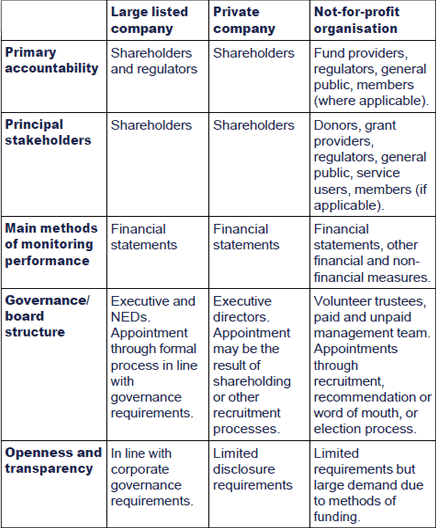
- Corporate governance is a matter of great importance for large public companies, where the separation of ownership from management is much wider than for small private companies.
- Public companies raise capital on the stock markets, and institutional investors hold vast portfolios of shares and other investments. Investors need to know that their money is reasonably safe.
- Should there be any doubts about the integrity or intentions of the individuals in charge of a public company, the value of the company’s shares will be affected and the company will have difficulty raising any new capital should it wish to do so.
- The scope of corporate governance for private and not-for-profit organisations will be much reduced when compared with a listed company, especially as there are no legal or regulatory requirements to comply with.
- The ownership and control, organisational objectives, risks and therefore focus may be different from a listed company. However, many of the governance principles will still be applicable to other entities.
- The public and not-for-profit sectors have voluntary best practice guidelines for governance which, while appreciating the differences in organisation and objective, cover many of the same topics (composition of governing bodies, accountability, risk management, transparency, etc.) included within the Combined Code.
- In not-for-profit organisations, a key governance focus will be to demonstrate to existing and potential fund providers that money is being spent in an appropriate manner, in line with the organisations’ objectives.

10 Internal corporate governance stakeholders
Within an organisation there are a number of internal partiesinvolved in corporate governance. These parties can be referred to asinternal stakeholders.
Stakeholder theory will be covered again later in this chapter, andin more detail in chapter 7. A useful definition of a stakeholder, foruse at this point, is 'any person or group that can affect or be affected by the policies or activities of an organisation'.
Each internal stakeholder has:
- an operational role within the company
- a role in the corporate governance of the company
- a number of interests in the company (referred to as the stakeholder 'claim').

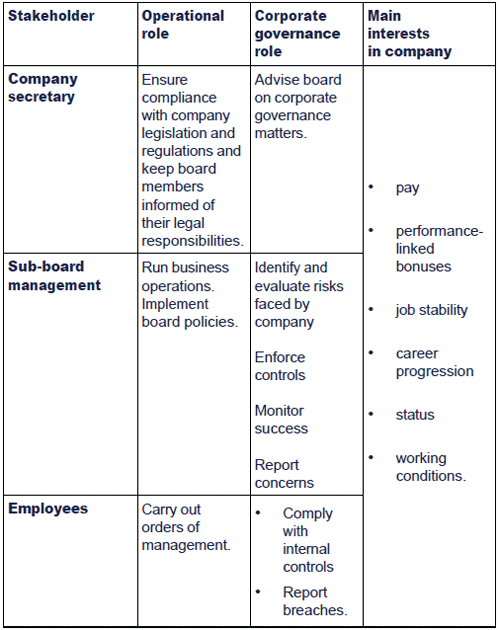
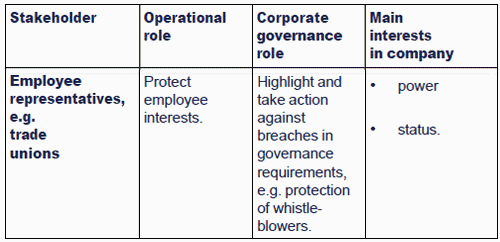

 Internal stakeholders
Internal stakeholders
The board of directors
- Has the responsibility for giving direction to the company.
- Delegates most executive powers to the executive management, but reserves some decision-making powers to itself, such as decisions about raising finance, paying dividends and making major investments.
- Executive directors are individuals who combine their role as director with their position within the executive management of the company.
- Non-executive directors (NEDs) perform the functions of director only, without any executive responsibilities.
- Executive directors combine their stake in the company as a director with their stake as fully paid employees, and their interests are, therefore, likely to differ from those of the NEDs.
- More detail on directors will be found in chapter 3.
The company secretary
- Often responsible for advising the board on corporate governance matters and ensuring board procedures are followed.
- Duties vary with the size of the company, but are likely to include:
- arranging meetings of the board
- drafting and circulating minutes of board meetings
- ensuring that board decisions are communicated to staff and outsiders
- completing and signing of various returns
- filing accounts with statutory authorities
- maintaining statutory documents and registers required by the authorities.
- Company secretary may act as the general administrator and head office manager. This role may include a responsibility for maintaining accounting records, corresponding with legal advisers, tax authorities and trade associations.
- Does not have the same legal responsibilities as directors.
- Should always act in the interests of the company in any event of conflict or dispute with directors.
- Is responsible to the board and accountable through the chairman and Chief Executive Officer (CEO) for duties carried out.
- Has the same interests and claims in the company as other employees.
- Remuneration package should be settled by the board or remuneration committee.
Management
- Responsible for running business operations.
- Accountable to the board of directors (and more particularly to the CEO).
- Will take an interest in corporate governance decisions which may impact their current position and potential future positions (as main board directors, possibly).
- Individual managers, like executive directors, may want power, status and a high remuneration.
- As employees, they may see their stake in the company in terms of the need for a career and an income.
Employees
- Have a stake in their company because it provides them with a job and an income.
- Have expectations about what their company should do for them, e.g. security of employment, good pay and suitable working conditions.
- Some employee rights are protected by employment law, but the powers of employees are generally limited.
Trade unions
- Primary interest will be in the pay and working conditions of their members.
- Will be concerned by poor corporate governance, for example lack of protection for whistleblowers or poor management of health and safety risks, and hence assist in the checks and balances of power within a company.
- Can ‘deliver’ the compliance of a workforce, particularly in a situation of business reorganisation.
- Can optimise industrial relations, easing workforce negotiations, and hence ensure an efficient and supportive relationship.
- Can be used by management of the company to distribute information to employees or to ascertain their views, hence can play a helpful role in business.
- Power of trade unions will vary between countries, with it being much stronger in countries such as France where union rights are extended to all employees.
11 External corporate governance stakeholders
A company has many external stakeholders involved in corporate governance.
Each stakeholder has:
- a role to play in influencing the operation of the company
- its own interests and claims in the company.
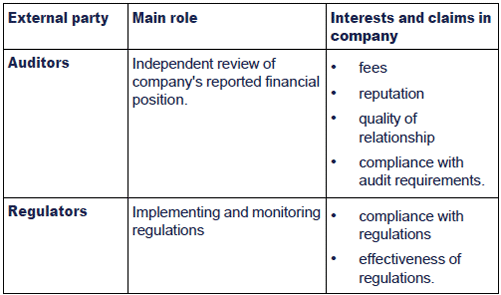
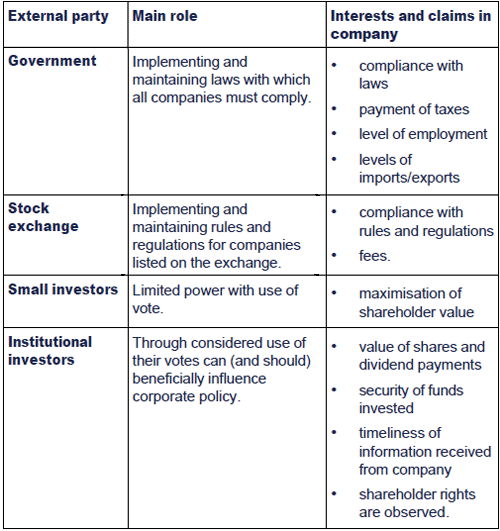
Chapter summary
Test your understanding answers

 Test your understanding 1
Test your understanding 1
B Management
They need detailed information in order to control their businessand make informed decisions about the future. Management informationmust be very up to date and is normally produced on a monthly basis.
Other parties will need far less detail:
- Competitors will be monitoring what the competition are currently planning and working on, but they will not be making the key decisions themselves.
- Trade unions will only require information which relates to their job role. They will only be particularly interested in disputes.
- Investors are interested in profitability and the security of their investment.


 Test your understanding 2
Test your understanding 2
The role of corporate governance is to protect shareholderrights, enhance disclosure and transparency, facilitate effectivefunctioning of the board and provide an efficient legal and regulatoryenforcement framework.

|
Created at 5/24/2012 3:27 PM by System Account
(GMT) Greenwich Mean Time : Dublin, Edinburgh, Lisbon, London
|
Last modified at 5/25/2012 12:53 PM by System Account
(GMT) Greenwich Mean Time : Dublin, Edinburgh, Lisbon, London
|
|
|
|
 |
Rating
:
|
 Ratings & Comments
(Click the stars to rate the page) Ratings & Comments
(Click the stars to rate the page)
|
 |
Tags:
|
|
|
|
|